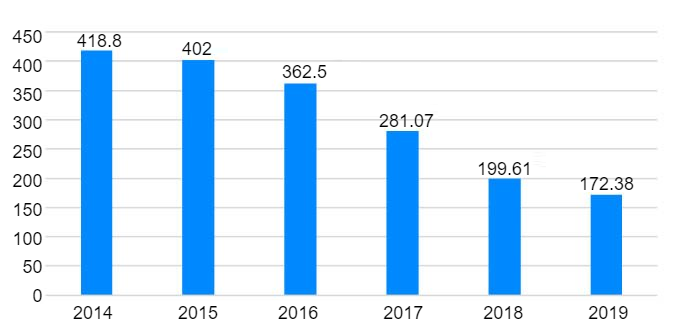The total consumption of antibiotics for human and animal health has been decreasing over time since the beginning of national programs aimed at achieving this important goal. When considering the consumption of antibiotics in animal health alone, veterinarians are making a great effort to educate pet owners and animal agriculture producers in order to lower the total antibiotic consumption. Specifically, in Spain, the Spanish National Antibiotic Resistant Plan (Plan Nacional frente a la Resistencia a los Antibióticos - PRAN) has just released data showing a total reduction of 13.6% in the sales of veterinary antibiotics in 2019 (27.2 mg/PCU or milligrams of active ingredient per Population Correction Unit). This information represents a 58.8% total reduction since the beginning of the program positioning the Spanish average of 172.4 mg/PCU closer to the European average of 107 mg/PCU registered in 2018 (Figure 1).
For this article, we asked our group of swine health experts about similar information specifically for their respective industries in the USA, Italy, Denmark, and Spain. We also asked them about the most successful steps they have taken in their veterinary practice to achieve this reduction.


Showing a similar trend as the Spanish data, Cano, Health Assurance director for the Pipestone System, highlights that the FDA results from 2015-2019 showed a persistent reduction in antibiotic usage with a total decrease of 40% over the last four years. USA producers have started diverse initiatives to monitor and transparently report antibiotic use. Specific for Pipestone, Cano described their internal web-based platform called PART (Pipestone Antibiotic Resistance Tracker), which allows producers and veterinarians to record, review, and respond for the responsible use of antibiotics. As part of Pipestone’s initiative to fight antimicrobial resistance (AMR), IMAGINE is a project to collect AMR data at the farm level. These data will be compared in real time with antibiotic use data from the PART program. This project aims to serve as a model for Responsible Antibiotic Use and Antimicrobial Resistance Surveillance.
Scollo, veterinarian responsible for the grow to finish facilities from the Suivet veterinary practice in Italy, participated with 36 of her grow to finish client’s farms in an Italian private research initiative. Results published early this year demonstrated a significant reduction of 66% in the last 4 years in almost 50% of all grow to finish farms. At the same time, Scollo says that there is still a significant percentage of producers that are not sensitive to the topic of antibiotic reduction in Italy and, therefore, more efforts should be made to try to reduce the levels of antibiotic usage in this segment of the industry.
Agerley of the Porcus veterinary practice explained that in Denmark, despite starting with a level of antibiotic usage that was 8 times lower than countries such as Spain, they were still able to achieve a 15% reduction in their usage over the last 4 years. This value is very accurately calculated and publicly available, as mentioned in our previous article. Agerley told us that this achievement is a result of the efforts performed daily by pig veterinarians. Denmark sets a maximum antibiotic consumption limit that is calculated based on real-time animal census (yellow card initiative). The consumption level is updated with every veterinary prescription. If a farmer passes this limit, they will get a “yellow card” that translates into sanctions and monetary fines. When this happens, the farm must create an action plan and are granted a 9-month period to decrease the consumption below the limit. (Figure 2)
UVESA, the Spanish company that Sanz represents, has always been below the Spanish antibiotic consumption average since they joined the PNRA. Their strong experience with the poultry business, where the levels of antibiotics for growing animals are extremely low, has helped them to go in this direction with their swine farms. Being certified as one of the leading companies in the meat sector has also motivated them to continually pursue this goal. Their antibiotic consumption has decreased by 50% from their initial levels and they keep working to improve these values.
When asked what their best strategies have been, Sanz described that they used antibiotic consumption to rank their sow farm flows. He explained how this ranking guided the decision they made to depopulate those farm flows with a high antibiotic consumption ranking for which long term antibiotic reduction was unlikely to be achievable. Example scenarios included farm flows with dysentery problems or virulent Actinobacillus pleuroneumoniae serotypes. In order to ensure that their production targets are met during the depopulation of these low-ranking sow farms, they have added an extra sow farm to their system. Improvements to management practices with a focus on the 4 basics (i.e. water, air, feed and space) have been a very important factor in bringing those farms with medium antibiotic consumption to a lower level of consumption thorough the reduction in stress levels.
Finally, he described their investigations into weaning piglets by removing the sow from the farrowing units. This approach would allow them to move piglets to the growing units at a more mature digestive state. All of these strategies reflect UVESA’s commitment to the continual elimination of antibiotics and, as of today, UVESA places 85-90% of all their finishing batches without using antibiotics at the entrance. As Sanz said, “it is especially important to always keep trying.”





